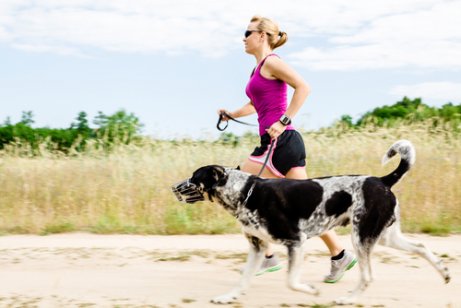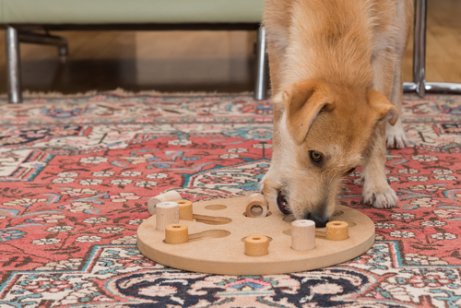Daily Exercise for Your Dog: What Is Enough?

Having your dog do a daily exercise routine is important. However, too much exercise or lack of exercise can cause behavior or health problems for your dog. This is where moderation is fundamental for them to be physically and mentally healthy.
- Benefits of Running with Your Dog
- What is Canicross?
- What is bikejoring?
Television programs and friends at the park constantly tell us that dogs must get plenty of exercise. However, it seems that they prefer to be lounging on the sofa to running in the yard.
The Nature of Dogs
Physical exercise is important, not just for humans, but for all animals too. In many cases, their health depends on moving the body and exercising often. Also, exercise not only prevents disease related to weight and obesity, but it’s also beneficial for the heart, mind, and hormones.
As a result, a dog that lacks daily exercise has is posed to developing a disease and may misbehave as well. All living beings have energy that needs to be used up. If they don’t get any exercise, this energy can convert into undesirable behaviors.
On the other hand, too much energy can be dangerous, can cause damage, pain and many other maladies. Excess energy can turn into bad behavior and usually destructive behavior. If a dog’s muscles hurt from exercising too much, they will try to relieve the pain by biting or scratching themselves wherever they can reach.
How Much Exercise Is Enough for a Dog Each Day?
Dogs, in general, are calm animals. In fact, they have the well-deserved reputation of being lazy. Their body is meant for them to be asleep for many hours a day. They won’t travel long distances in search of food and will resort to eating what is close to them.

When you get your dog to exercise, remember to consider the advice above along with some other information. Also, you also need to consider the age and size of the dog among other physical traits.
Even if they might be nervous, you shouldn’t force a puppy to exercise. All of the energy they already have will be spent on exercising. You should play with them, but give them time to rest and finish developing. When a puppy is between a one year and a half or two, you should then start taking them on runs or getting them to exercise.
Consider the Dog’s Age
Adult dogs from two to five years old can exercise with us if they feel like it. Like humans, they need to warm up ahead of time. From the age of seven years old, their bones and joints begin to weaken. Therefore, we’ll need to be less demanding when it comes to exercise for our dogs. Eventually, we’ll need to completely eliminate it.
Except for certain cases when the veterinarian recommends it, it’s not necessary to obligate a dog to run with us or chase a ball for daily exercise. Normally, three good walks are sufficient for a dog’s needs.
For an adult dog, three walks in a day that add up to an hour and a half in the street is enough exercise. Dogs don’t walk in a straight line so they actually walk much farther than we do. With luck, your dog will meet up with another dog in the park and they’ll run a couple of races!

Normal daily exercise is beneficial for dogs. In fact, it has a purpose since they are doing interesting things while moving their bodies. There is also a chance to stop whenever necessary.
The Importance of the Dog’s Size
You shouldn’t overlook the size and traits of your dog. You need to think about this when it comes to daily exercise and how much is necessary. A small dog needs to put forth more effort than a medium or large dog. In addition, they have more fragile bodies.
On the other hand, very large dogs tend to have joint pain. Dogs with short legs and a long torso should not exercise more than their daily routine. For very small dogs, daily walks are even more exercise than recommended.
To find out how much exercise your dog should have, you first need to look at and know your dog. What is their body like? What is their state of health, age, wants, etc. There are many factors to consider in order to come to a conclusion.
Don’t Forget Mental Exercise
When thinking about exercise, physical exercise always comes to mind. Few people think about mental exercise. It doesn’t help a dog at all if they’re running after a ball for a half hour and then goes home and is terribly bored. Boredom also creates bad behavior.
The vast number of dogs receive sufficient physical exercise in their daily routines. However, you should think more about mental exercise.

It’s very simple to give dogs something to think about. Ten minutes a day is enough time to spend playing mental games. You can even do this without toys: following odors, going to a new park and seeing and sniffing other dogs. Another game is to hide pieces of food around the house and allow the dog to find them.
You can also do this with toys. There are interactive toys, puzzles for dogs or rugs with aromas. These are some of the basic methods of mental stimulation for dogs.
Before deciding how much exercise to give a dog, you need to consider their age and physical condition. Equally important is to provide them with mental stimulation. This will promote good behavior and happiness in your canine friend.
Having your dog do a daily exercise routine is important. However, too much exercise or lack of exercise can cause behavior or health problems for your dog. This is where moderation is fundamental for them to be physically and mentally healthy.
- Benefits of Running with Your Dog
- What is Canicross?
- What is bikejoring?
Television programs and friends at the park constantly tell us that dogs must get plenty of exercise. However, it seems that they prefer to be lounging on the sofa to running in the yard.
The Nature of Dogs
Physical exercise is important, not just for humans, but for all animals too. In many cases, their health depends on moving the body and exercising often. Also, exercise not only prevents disease related to weight and obesity, but it’s also beneficial for the heart, mind, and hormones.
As a result, a dog that lacks daily exercise has is posed to developing a disease and may misbehave as well. All living beings have energy that needs to be used up. If they don’t get any exercise, this energy can convert into undesirable behaviors.
On the other hand, too much energy can be dangerous, can cause damage, pain and many other maladies. Excess energy can turn into bad behavior and usually destructive behavior. If a dog’s muscles hurt from exercising too much, they will try to relieve the pain by biting or scratching themselves wherever they can reach.
How Much Exercise Is Enough for a Dog Each Day?
Dogs, in general, are calm animals. In fact, they have the well-deserved reputation of being lazy. Their body is meant for them to be asleep for many hours a day. They won’t travel long distances in search of food and will resort to eating what is close to them.

When you get your dog to exercise, remember to consider the advice above along with some other information. Also, you also need to consider the age and size of the dog among other physical traits.
Even if they might be nervous, you shouldn’t force a puppy to exercise. All of the energy they already have will be spent on exercising. You should play with them, but give them time to rest and finish developing. When a puppy is between a one year and a half or two, you should then start taking them on runs or getting them to exercise.
Consider the Dog’s Age
Adult dogs from two to five years old can exercise with us if they feel like it. Like humans, they need to warm up ahead of time. From the age of seven years old, their bones and joints begin to weaken. Therefore, we’ll need to be less demanding when it comes to exercise for our dogs. Eventually, we’ll need to completely eliminate it.
Except for certain cases when the veterinarian recommends it, it’s not necessary to obligate a dog to run with us or chase a ball for daily exercise. Normally, three good walks are sufficient for a dog’s needs.
For an adult dog, three walks in a day that add up to an hour and a half in the street is enough exercise. Dogs don’t walk in a straight line so they actually walk much farther than we do. With luck, your dog will meet up with another dog in the park and they’ll run a couple of races!

Normal daily exercise is beneficial for dogs. In fact, it has a purpose since they are doing interesting things while moving their bodies. There is also a chance to stop whenever necessary.
The Importance of the Dog’s Size
You shouldn’t overlook the size and traits of your dog. You need to think about this when it comes to daily exercise and how much is necessary. A small dog needs to put forth more effort than a medium or large dog. In addition, they have more fragile bodies.
On the other hand, very large dogs tend to have joint pain. Dogs with short legs and a long torso should not exercise more than their daily routine. For very small dogs, daily walks are even more exercise than recommended.
To find out how much exercise your dog should have, you first need to look at and know your dog. What is their body like? What is their state of health, age, wants, etc. There are many factors to consider in order to come to a conclusion.
Don’t Forget Mental Exercise
When thinking about exercise, physical exercise always comes to mind. Few people think about mental exercise. It doesn’t help a dog at all if they’re running after a ball for a half hour and then goes home and is terribly bored. Boredom also creates bad behavior.
The vast number of dogs receive sufficient physical exercise in their daily routines. However, you should think more about mental exercise.

It’s very simple to give dogs something to think about. Ten minutes a day is enough time to spend playing mental games. You can even do this without toys: following odors, going to a new park and seeing and sniffing other dogs. Another game is to hide pieces of food around the house and allow the dog to find them.
You can also do this with toys. There are interactive toys, puzzles for dogs or rugs with aromas. These are some of the basic methods of mental stimulation for dogs.
Before deciding how much exercise to give a dog, you need to consider their age and physical condition. Equally important is to provide them with mental stimulation. This will promote good behavior and happiness in your canine friend.
All cited sources were thoroughly reviewed by our team to ensure their quality, reliability, currency, and validity. The bibliography of this article was considered reliable and of academic or scientific accuracy.
Pellegrino, F. J., Risso, A. L., Arias, D. O., Blanco, P. G., & Corrada, Y. (2014). Optimización del rendimiento deportivo en caninos. Revista de Investigaciones Veterinarias del Perú, 25(4), 449-454.
International Association of Animal Behavior Consultants (2019) Manual de Entrenamiento Canino. IAABC. Recuperado el 29 de mayo de 2022, disponible en: https://m.iaabc.org/docs/espanol/IAABCManual_digitalv120919.pdf
This text is provided for informational purposes only and does not replace consultation with a professional. If in doubt, consult your specialist.








